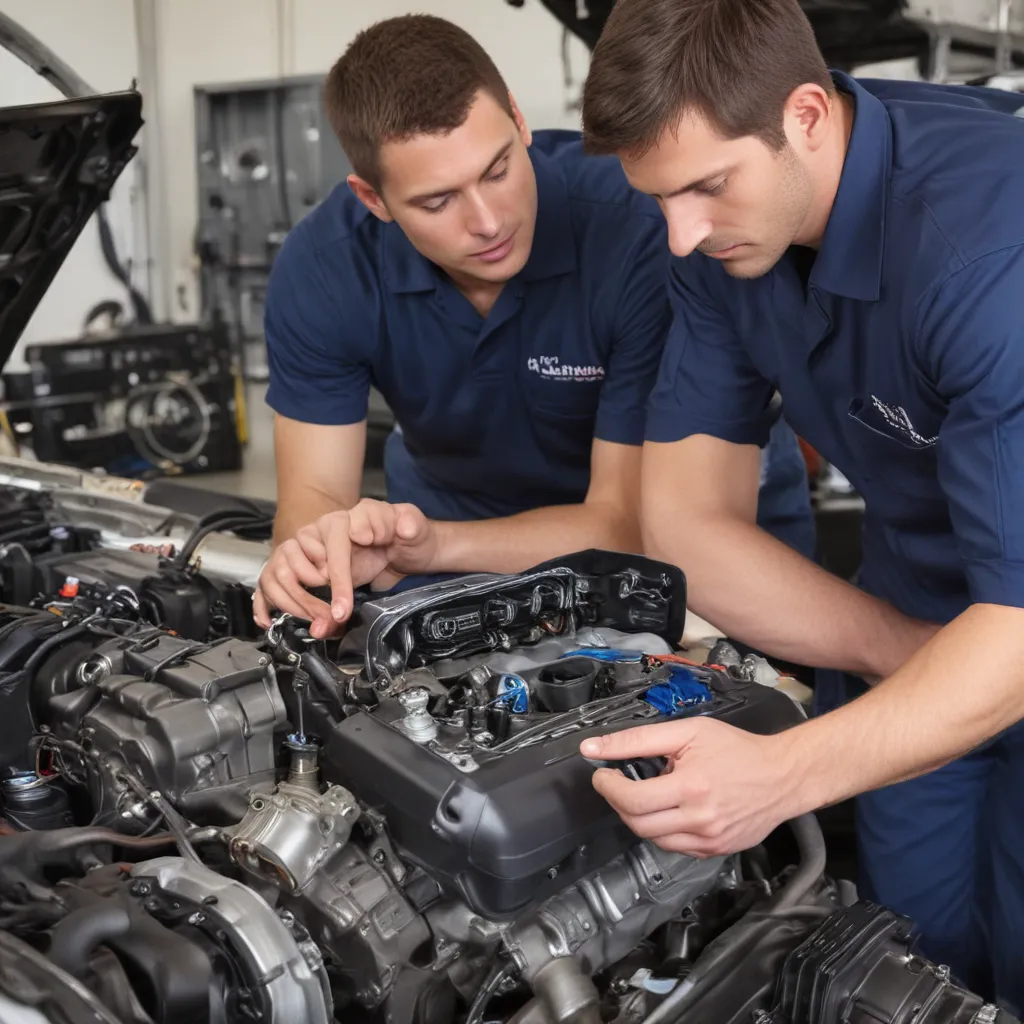
The Mysterious Workings of the Internal Combustion Engine
Ah, the internal combustion engine – that enigmatic beast that powers our beloved RVs and fleet vehicles. It’s like a miniature volcano, spewing forth a symphony of explosions and vibrations, all in the name of propelling us down the open road. As an RV and fleet repair technician, I’ve had the pleasure (and occasional headache) of diving into the guts of these mechanical marvels, uncovering their secrets and ensuring they continue to roar with life.
You see, the heart of any vehicle is its engine, a complex amalgamation of pistons, valves, and a dizzying array of sensors and components. It’s like a high-performance orchestra, with each part playing a crucial role in the grand performance of moving us from point A to point B. But when something goes awry, it can be a veritable cacophony of trouble – sputtering, chugging, and the dreaded “check engine” light that sends shivers down every driver’s spine.
That’s where engine diagnostics come into play, my friends. It’s the art of deciphering the language of your vehicle’s engine, translating those cryptic codes and symptoms into actionable insights. It’s like being a automotive Sherlock Holmes, piecing together the clues to uncover the root cause of any malady affecting your RV or fleet vehicle.
Unlocking the Secrets of the Engine Diagnostic Process
So, how does one go about this engine diagnostic detective work, you ask? Well, buckle up, because we’re about to embark on a journey deep into the heart of your vehicle’s engine.
First and foremost, we’ll start with a thorough visual inspection. We’ll poke, prod, and peer into every nook and cranny, looking for any obvious signs of wear, damage, or suspicious activity. It’s like a medical check-up for your car – we’ll examine the external parts, check for any fluid leaks, and scrutinize the belts and hoses for any signs of deterioration.
Next, we’ll delve into the digital realm, connecting your vehicle to our state-of-the-art diagnostic equipment. This is where the real magic happens, my friends. Our sophisticated scanners will tap into your engine’s central nervous system, reading the various codes and data points that can reveal a wealth of information about its health and performance.
“It’s like being a automotive Sherlock Holmes, piecing together the clues to uncover the root cause of any malady affecting your RV or fleet vehicle.”
Now, I know what you’re thinking – “Codes? Data points? Isn’t this just going to give me a bunch of technical jargon that I can’t make heads or tails of?” Fear not, my dear RV and fleet owners, for we’re here to translate this digital hieroglyphics into plain English. We’ll take those cryptic codes and use our extensive knowledge and experience to identify the specific issues at hand, whether it’s a faulty sensor, a problem with the fuel system, or something more complex.
Diagnosing the Symptoms: A Deeper Dive
But the diagnostic process doesn’t stop there, oh no. We’ll delve even deeper, using a variety of specialized tools and techniques to pinpoint the exact cause of the problem. This could involve everything from performing a compression test to check the engine’s health, to analyzing exhaust emissions to identify any issues with the fuel or ignition systems.
One of the most crucial steps in the diagnostic process is the good old-fashioned road test. We’ll take your RV or fleet vehicle out for a spin, putting it through its paces and monitoring its performance under real-world conditions. This allows us to replicate the symptoms you’ve been experiencing and gather even more data to help us zero in on the root cause.
“It’s like a medical check-up for your car – we’ll examine the external parts, check for any fluid leaks, and scrutinize the belts and hoses for any signs of deterioration.”
And let’s not forget about the importance of good old-fashioned troubleshooting. Sometimes, the answer isn’t hidden behind a complex array of codes and data points – it’s right there in front of us, waiting to be discovered through a methodical process of elimination. We’ll systematically test and replace components, always keeping an open mind and a keen eye for any unexpected clues that could lead us to the solution.
Restoring Health and Performance: The Road Ahead
But the real magic happens once we’ve identified the issue, my friends. Armed with our diagnostic findings, we can now embark on the journey of restoring your RV or fleet vehicle to its former glory. Whether it’s a simple repair or a more complex overhaul, we’ll use our expert skills and high-quality parts to get your engine running like new.
And let me tell you, there’s nothing quite like the feeling of seeing that “check engine” light finally flick off, and hearing the smooth, powerful purr of a well-tuned engine. It’s like witnessing a phoenix rise from the ashes, a testament to the resilience and ingenuity of these remarkable machines.
“Armed with our diagnostic findings, we can now embark on the journey of restoring your RV or fleet vehicle to its former glory.”
Of course, the work doesn’t end there. Regular maintenance and preventative care are crucial to keeping your engine in peak condition, and we’ll work closely with you to develop a tailored service plan that ensures your RV or fleet vehicle continues to perform at its best, mile after mile.
So, there you have it, my friends – the ins and outs of engine diagnostics, from the mysterious inner workings of the internal combustion engine to the art of uncovering and resolving any issues that may arise. It’s a journey of discovery, problem-solving, and ultimately, the restoration of your vehicle’s health and performance.
And if you’re ever in the Orange County area and in need of RV or fleet repair services, you know where to find us. Visit our website to learn more about our capabilities and how we can help keep your engines roaring with life. Happy travels!
